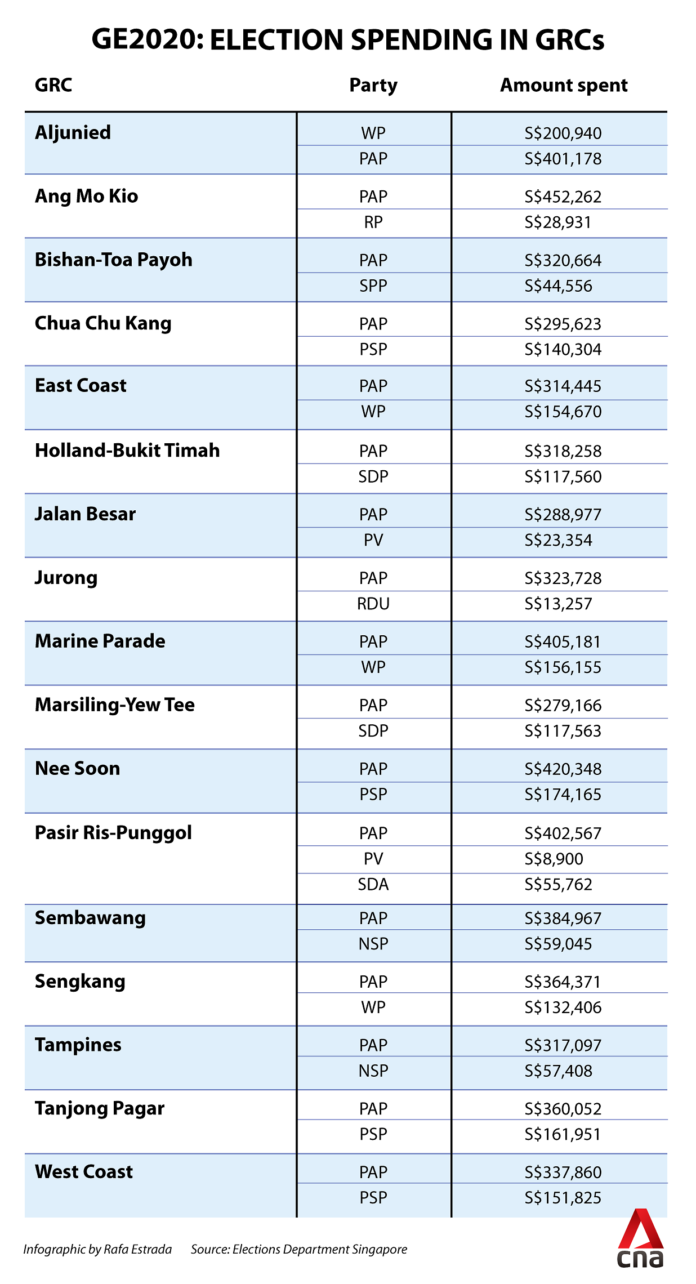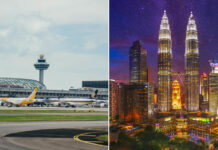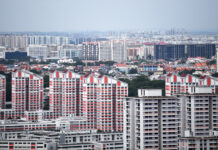SINGAPORE: Candidates from the People’s Action Party (PAP) spent S$6.97 million on the 2020 General Election last month, while opposition candidates spent S$2.19 million.
In all, the 192 candidates who contested the General Election spent a total of S$9.16 million, with the bulk of the money going towards advertising, according to records released by the Elections Department (ELD) on Friday (Aug 21).
This is about 30 per cent more than the S$7.1 million spent during the previous General Election in 2015.
All 93 seats in 31 constituencies were contested by 191 candidates from 11 political parties and one independent candidate.
The PAP won 83 seats in the election and garnered 61.2 per cent of the popular vote.
An analysis of the expense submissions also showed that candidates across all parties spent significantly less than the S$4 allowed per voter.
Under the Parliamentary Elections Act, all candidates who contested in the Jul 10 polls must declare their election expenses. These are available for inspection from Friday until Feb 20, 2021.
READ: GE2020: Election expenses returns open for inspection on Aug 21
Among opposition parties, newcomer Progress Singapore Party (PSP) – which contested nine constituencies in the election – was the biggest spender at S$781,275.
The Workers’ Party (WP) came in next with S$705,647 spent in the six constituencies it ran in. The Singapore Democratic Party (SDP) spent S$323,292 contesting in five wards.
Other parties forked out between S$11,000 and slightly more than S$116,000, while the sole independent candidate, Mr Cheang Peng Wah, put in S$31,537 towards his election bid in Pioneer SMC.
One political watcher said it was not a surprise that PSP’s expenses came in higher.
“For a new party in particular, the need to get the message out there in what is a very crowded opposition space in a very short time probably necessitated that sort of higher spending,” said political analyst Eugene Tan, an associate professor of law at the Singapore Management University.
Mr Tan also said that higher spending could be attributed to the larger electorate of 2,651,435 registered electors.
READ: GE2020: 4,794 votes cast overseas, taking total voter turnout this election to 95.81%
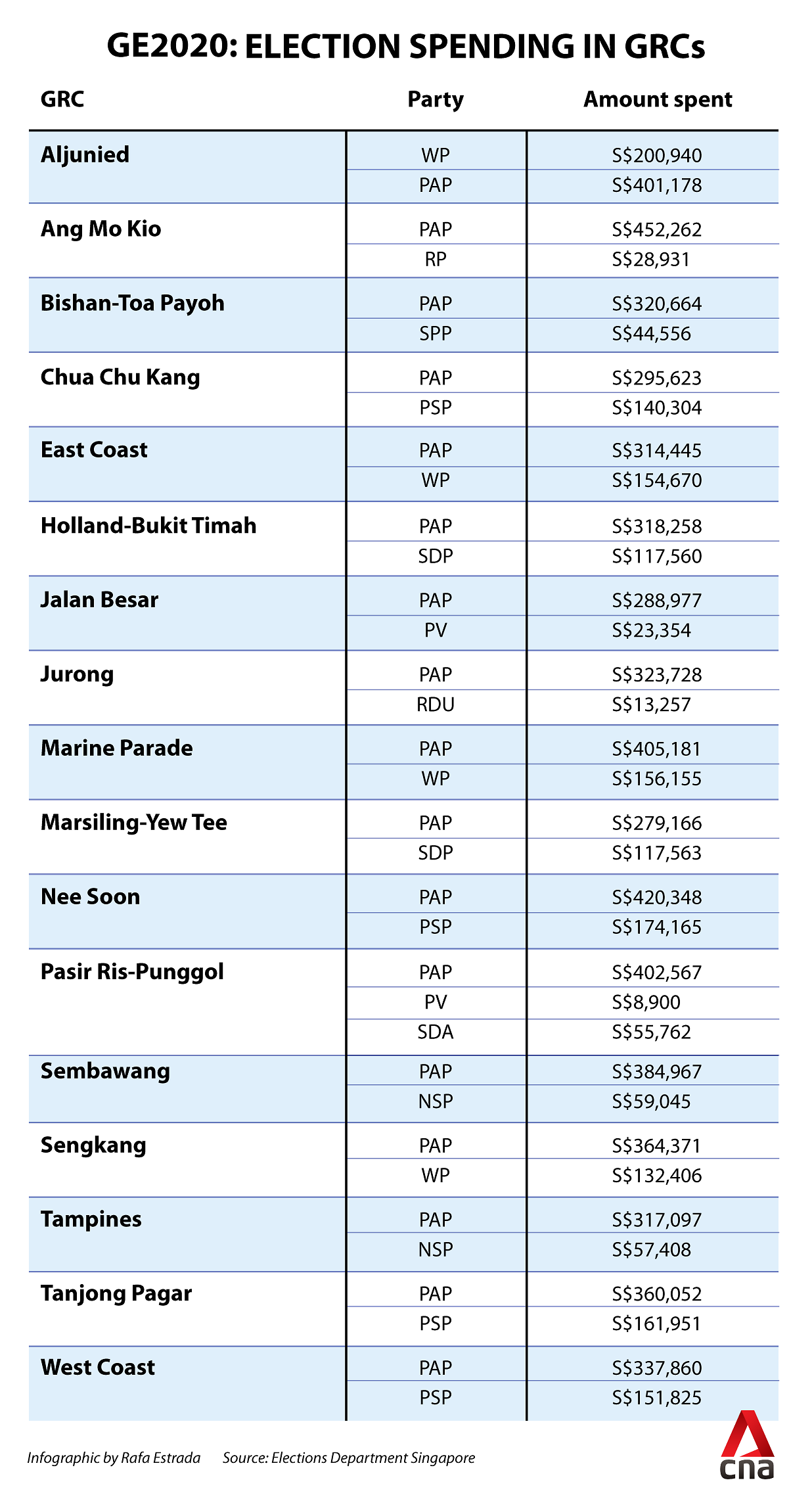
WHO SPENT THE MOST AND THE LEAST?
Among the Group Representation Constituencies (GRCs), the five-member PAP Ang Mo Kio GRC team led by Prime Minister Lee Hsien Loong topped the table, spending S$452,262.
There were 185,465 voters in Ang Mo Kio GRC. PAP won the ward with 71.91 per cent of the vote over a Reform Party team that spent S$28,931. Per voter, PAP spent S$2.44 in Ang Mo Kio GRC.
Averaging out cost by voter, however, the four-member PAP team in Bishan-Toa Payoh GRC spent the most – S$3.17 per elector. Bishan-Toa Payoh, with 101,366 voters, is the smallest GRC in terms of electors. PAP won with 67.26 per cent of the vote against Singapore People’s Party.
A Peoples Voice team in Pasir Ris-Punggol kept costs to S$8,900 in total – the lowest among the GRCs and the lowest per voter (S$0.05). They were in a three-cornered fight for the ward against the PAP, which spent S$402,567, and the Singapore Democratic Alliance, whose campaign cost them S$55,762. There were 166,556 electors in Pasir Ris-Punggol and it is the largest GRC.
Among the Single Member Constituencies (SMCs), Mr Liang Eng Hwa of Bukit Panjang SMC had the highest expenditure of S$110,510. Most of this went to advertising on print and the Internet. His opponent, SDP’s Paul Tambyah, spent S$29,390.
With 35,437 electors, Bukit Panjang is the largest SMC and Mr Liang’s costs work out to S$3.12 per voter, lower than Punggol West SMCs’ Ms Sun Xueling’s S$3.47 per voter.
PV’s Sivakumaran Chellappa, who contested and lost in Mountbatten, spent the least among SMC candidates with S$7,786 in total, or S$0.32 per voter. There were 24,246 voters in Mountbatten.
LITTLE SPENDING ON INTERNET ADS
In all, candidates spent a combined S$7.82 million on election advertising, which is more than 85 per cent of all election expenses.
The majority of that was on print election advertising, which would include posters and banners, amounting to S$5.6 million.
While GE2020 was called an Internet election, as there were no physical rallies due to the COVID-19 pandemic, most parties spent little or nothing on Internet election advertising.
The exceptions were the PAP and SDP. Of the nearly S$2 million all parties spent on Internet election advertising, S$1.8 million was from the PAP and about S$138,000 from the SDP.
Three parties, including WP, did not spend anything on Internet advertising while each of six other parties spent between S$105 and S$6,970.
No details were provided on what specific services and items the candidates or parties purchased.
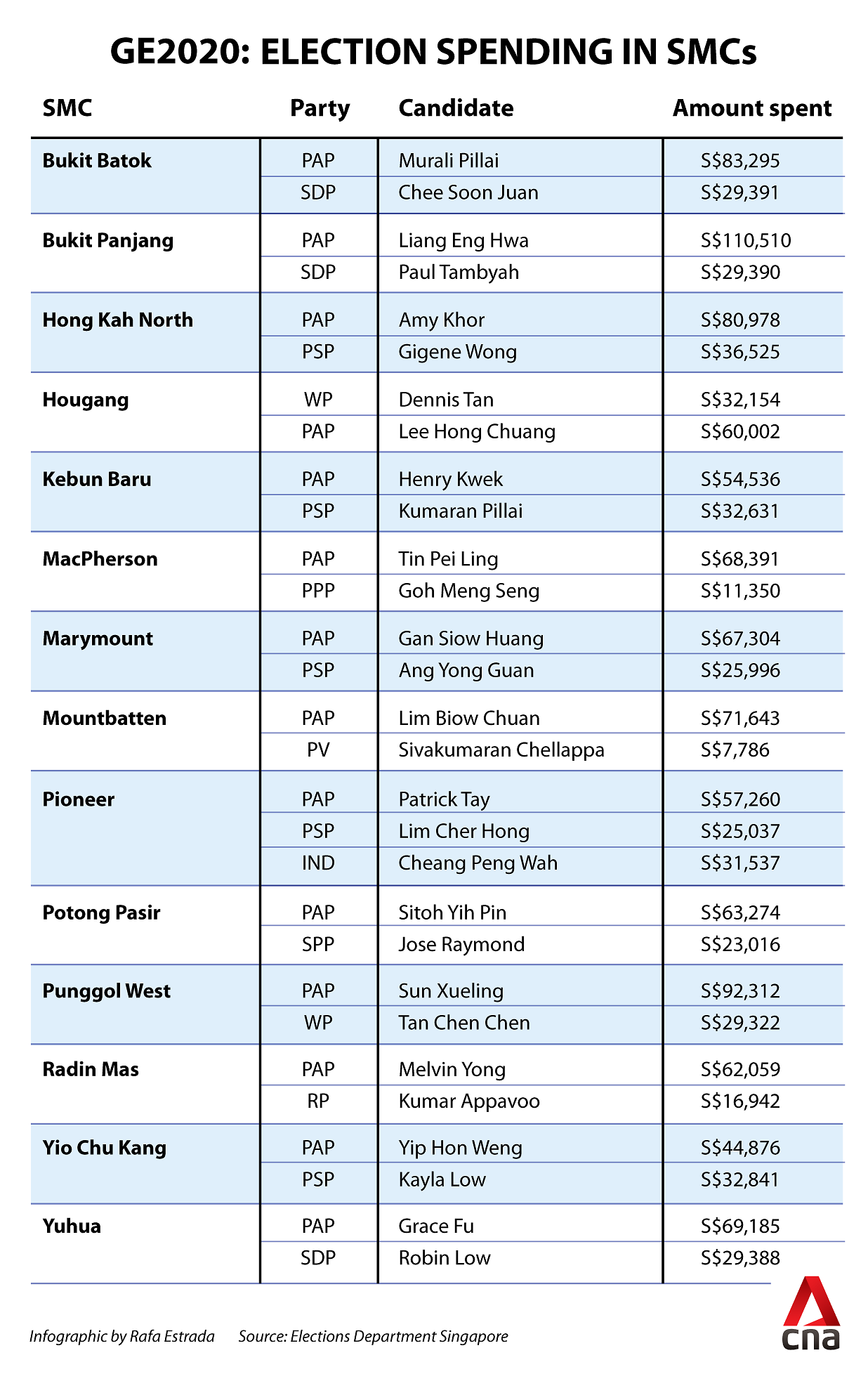
AMOUNT SPENT PER VOTER
The PAP spent about S$2.63 per voter across all constituencies, more than double the amount spent by opposition parties on average, but way below the S$4 cap allotted for each voter under election rules.
The WP spent S$1.21 per voter, while PSP spent S$1.19 and SDP’s expenditure was S$1.01 per voter.
The party that spent the least, at S$0.10 per voter, was Red Dot United. It spent S$13,257 to contest one constituency – Jurong GRC, losing to the PAP team led by Senior Minister Tharman Shanmugaratnam. PAP’s team had spent S$323,728 on their campaign in Jurong GRC, which had 131,058 electors, taking its per voter spend to S$2.47.
In all wards, PAP candidates outspent their opponents. Here are the figures for some hotly contested constituencies:
ALJUNIED GRC
In Aljunied, the PAP was looking to take back the seat from the WP, which it had won in the 2011 election. In 2015, PAP closed the gap, leading some to speculate it could win the GRC this time round.
However, despite replacing two veterans in its Aljunied team, WP extended its majority, winning with 59.95 per cent of votes against the PAP.
The PAP spent S$401,178 in Aljunied, which had 150,821 electors, while the WP spent S$200,940 in that contest.
EAST COAST GRC
A last-minute move by Deputy Prime Minister Heng Swee Keat made this constituency one to watch in the election, especially as WP had fielded strong candidates there.
PAP held on to the GRC but with a narrower margin than in 2015, winning 53.41 per cent of the votes.
The PAP spent S$314,445 in East Coast, which had 121,644 electors, against WP’s S$154,670.
SENGKANG GRC
Sengkang, a new GRC, became the second GRC ever to fall into opposition hands, upping the number of seats WP has in Parliament to 10.
WP’s young team, which include lawyer He Tingru and Dr Jamus Lim – who emerged as a star candidate during the campaign – garnered 52.12 per cent of votes, narrowly beating the PAP team helmed by then-Minister Ng Chee Meng.
PAP had spent S$364,371 on Sengkang, which had 120,100 electors, more than twice WP’s S$132,406.
WEST COAST GRC
West Coast GRC was the narrowest win for PAP on polling night, with the team led by Minister for Communications and Information S Iswaran pulling 51.68 per cent of votes. They had faced stiff competition from PSP’s team, which was led by party chief Tan Cheng Bock.
PSP’s Hazel Poa and Leong Mun Wai will take up the two Non-Constituency Members of Parliament (NCMP) seats offered to the party.
The PAP spent S$337,860 in West Coast, which had 146,089 electors, versus the PSP’s S$151,825.
Those who wish to inspect the election expenses should make an appointment with the ELD at least one working day in advance via email to joyce_kow@eld.gov.sg and ng_hui_peng@eld.gov.sg. A fee of S$2 is charged for each record requested.
Additional reporting by Brandon Tanoto.
BOOKMARK THIS: Our comprehensive coverage of GE2020 and its developments
Download our app or subscribe to our Telegram channel for the latest updates: https://cna.asia/telegram
